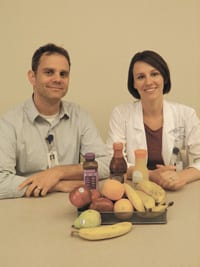Slowly, But Surely May Center Treats Autism With Patience
‘Joe’ is a 10-year-old with autism.
Like all those who have this developmental disability, Joe (that’s a pseudonym) has exhibited a number of unusual behavioral patterns and has problems with communication and social interaction.
He doesn’t speak much, and when he does talk he is usually repeating what others say or recalling lines from favorite movies like The Lion King. This is called echolalia. Meanwhile, he still eats one type of food only — saltine crackers — and one brand of cracker. He’s also prone to hitting, kicking, or biting those around him, and still prefers to do most things by himself.
But Joe is getting better — much better.
Indeed, he is expanding his diet to other types of food, and the frequency of his violent acts is down considerably — from about 200 or 300 a day when he arrived at school last fall to perhaps a half-dozen a day. And he’s talking more and saying things at more appropriate times, not
merely shouting things out when he feels an urge.
Joe’s progress is typical of the work that goes on at the May Center for Child Development in West Springfield. Opened last fall on the second floor of the former Immaculate Conception School building, the May Center — one of several facilities operated by the Norwood-based May Institute — is a place where children ages 3 to 12 who cannot learn in a traditional school setting for one reason or another come for specialized education and treatment.
Using a process known as applied behavior analysis (ABA), staff members facilitate the development of language, positive skills development, and social behavior through intervention — the use of positive reinforcement, repetition, and prompting, said Dr. Shannon Kay, the center’s director and a board-certified behavioral specialist.
Progress with children who have autism, pervasive development disorder (PDD), and other developmental disabilities is measured in increments — usually very small increments, said Kay, who put emphasis on the word small. In the case of Joe, it took several weeks to get him to even put some type of food other than saltine crackers on the tip of his tongue.
“Joe is in many ways a work in progress, but that’s what you need to focus on — the fact that we’re seeing progress,” she said. “Every day, he moves forward … that’s what motivates us.”
There are many other success stories being written at the center, which currently has nine students and is in the process of preparing classroom space to accommodate up to 20.
The Healthcare News looks this month at the May Center and how its staff goes about creating a better quality of life for people like Joe.
On a Roll
As she talked with The Healthcare News in her office, Kay often had to raise her volume level to be heard over the rumbling of a shopping cart as it was pushed over the hardwood floors of the century-old Immaculate Conception School.
The cart, one of those that is disguised as a race car and therefore popular with young children, was donated to the center by Big Y. It has become the reward of choice for many of the students, who earn trips up and down the hall as they record discernable progress toward a goal — be it the elimination of a behavioral problem, the addition of new words or phrases, or even a willingness to experiment with new foods. Other rewards include time with toys, books, or video games, and even a hug.
“Here, we focus on getting children to learn how to learn,” said Kay, adding that for many individuals this is a stern challenge, not only for them, but also for their parents and those trying to educate them.
Noting that there are many children in Western Mass. with autism and other developmental disabilities, and that some of these individuals need a highly structured environment and specialists in behavior analysis, the May Institute opened its center in West Springfield last year, said Alan Harchik, Ph.D., BCBA, senior vice president at the May Institute.
The institute had been providing consultative services to area school systems who have students with autism and related disabilities, and still does, said Harchik, but it created the center to take its services in Western Mass. to a higher level. May operates similar schools for children and adolescents in Arlington, Braintree, and Chatham, Mass., as well as in Freeport, Maine. It also has a school for youths with brain injuries in Brockton, Mass.
“Inclusion in a traditional, public school setting works for some children, but it doesn’t work for all of them,” Harchik said of the decision to create the Western Mass. facility, the only one of its kind in the area. “We opened the school in response to an increase in the demand for such services.”
Kay, who came to the school after studying psychology at UMass and working in the field of “school psychology” — the study of how people learn — said the May Center is unique because of its personal, one-on-one approach and its use of ABA.
She told The Healthcare News that students attend the school for six hours a day, year-round — at a cost of about $60,000 per student, with that burden absorbed by the child’s school district. The facility is staffed with trained instructors and teachers who, in addition to their degrees in psychology and experience in behavior analysis, possess large quantities of patience. That’s because the students take baby steps in their progress on issues ranging from the learning of shapes and colors to toilet training.
Kay said that most students will be at the school for about three years before being integrated into a traditional school setting, and that the degree of progress that can be achieved with a particular individual — and the likelihood of re-integration — is usually a function of how early they can begin specialized education.
She said the cause of autism, a neurological disorder that affects the development of the brain, is not known. What is known is that it typically appears in the first three years of life, and is four times more likely to occur in boys than girls.
What’s also known — and noted with a good deal of anxiety — is that the number of diagnosed cases of autism and similar disorders has dramatically increased over the past decade. Kay said she’s not sure if this statistic is attributable to better methods of diagnosing the affliction or the fact that it is becoming more common. What is clear, she said, is there is a growing need for specialized facilities like the May Center.


